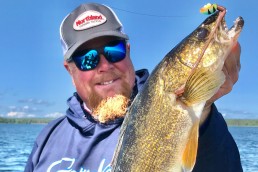Summer Change for Walleyes
SHARE THIS POST
The natural world is in constant change, so Brian Brosdahl responds to the changes in walleye behavior to keep catching them throughout the summer.
Change can sharpen some things and make other things disappear. Fishing is a series of patterns. Some fishing patterns occur daily. Fish have to deal with changes in the weather, while keeping constant track of their food sources. They are constantly reacting to their environment, so the more anglers can understand about fish, the easier fishing becomes.
Fish live nomadic lives, moving around their environment, utilizing different resources at different times of the year. Fish move from one situation to the next as the availability of food changes over time. Baitfish also respond to their own set of patterns.
By the time summer fishing patterns are established, the minnow spawn has finished, the major insect hatches are over and predator species are looking for the next best feeding opportunity in the lake.
Fish are looking for places that provide a plentiful food source along with comfort and safety. When you think about it, that’s not much different than most people.
Early in the summer, walleyes are more spread out than at any other time of the year. There are usually several different feeding patterns happening at the same time in different locations in the lake.
Oxygen levels are still good in deep water, so some walleyes will be deep. The weed beds are fully developed, so some walleyes are in the weeds. There are baitfish suspended over the basin, some near structure and some not. There will be walleyes on the flats, some in moderate depths and others over the mud basin.
Oxygen levels don’t start to drop until the thermocline sets up and stratifies the water column. Fish can be as shallow or as deep as they want to be in early summer, as long as they can find enough food to eat and oxygen levels are high enough to support the fish.
Walleyes are capable of feeding at different times of day. There can be low-light-feeding walleyes, walleyes that feed after dark and,
Are you enjoying this post?
You can be among the first to get the latest info on where to go, what to use and how to use it!
fortunately, there are lakes where walleyes feed during the day. These lakes often have stained or turbid water. Walleyes feeding on perch and crayfish also tend to feed during the day, because that’s when their forage is most active.
Fish are cold-blooded. They move faster when the water is warm and slower when the water is cold. Summer fishing patterns begin to take hold about the same time surface water temperatures exceed 70 degrees.
My G3 Humminbird Helix 12 is my eyes for finding fish, structure and baitfish. I can see individual fish, schools of fish and tell the relative size and species of fish to a high degree of certainty.
Anglers fishing summer patterns usually need to cover more water to catch walleyes. I am always scouting while I am fishing, watching for fish on side imaging and sonar.
Anglers want to present their baits to as many walleyes as possible. Walleyes are more willing to chase baits when the water temperatures are warmer than 70 degrees. Spinner rigs are the perfect presentation to get a walleye’s attention and get them to come to the bait from longer distances.
Spinners can be rigged many different ways. I start with micro spinners or Northland Butterfly Spinners that turn at slower speeds. I work my way up to different types and sizes of spinners as the season progresses.
Get more useful fishing insight from the pros who know in every issue of MidWest Outdoors, available by subscribing on our website.
MWO
SHARE THIS POST
You may also like...
Nothing found.
Did you enjoy this post?
You can be among the first to get the latest info on where to go, what to use and how to use it!
Brian 'Bro' Brosdahl
Outdoor communicator Brian “Bro” Brosdahl lives in northern Minnesota. He is a walleye guide in the Cass Lake, Leech Lake and Lake Winnibigoshish areas. He is sponsored by Northland Fishing Tackle, Frabill/Plano, Aqua-Vu, Humminbird/Minn Kota, St. Croix Rods, Ranger Boats, and Evinrude. Guide inquiries: brosguideservice.com. Follow on social media.
